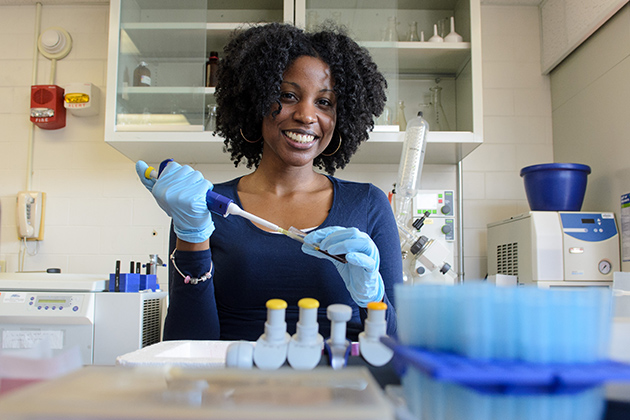
Patrice Hubert ’12 (CANR) has always been interested in science and health, but couldn’t handle the sight of blood or the notion of pain – a trait she suspected might get in the way of her career plans.
“I always wanted to help people, but I thought the only way I could really do it was if I became a doctor,” says Hubert, a recent graduate who ultimately decided against attending medical school and found a different way to pursue her love of the sciences.
Thanks to the Bridge to the Doctorate, a new fellowship program recently launched at the University with support from the National Science Foundation (NSF), the 22-year-old Connecticut native is now not only aiming to earn a Ph.D. in nutritional sciences, but will do so knowing that the funding for her first two years of graduate study has already been secured.
Expertise in high demand
From physicists and microbiologists to mechanical engineers and astronomers, advanced education in the fields of science, technology, engineering, and mathematics – also known as STEM – is in greater demand than ever before. STEM jobs have grown three times faster than non-STEM jobs over the past decade, and STEM workers are earning 26 percent more than their non-STEM counterparts, according to the U.S. Department of Commerce’s Economics and Statistics Administration.
Yet the number of students from underrepresented minorities seeking advanced degrees in these fields remains low. Underrepresented students today comprise less than 1 percent of Ph.D.’s conferred in the U.S. in the hard STEM disciplines, says Joy Erickson, coordinator of the Louis Stokes Alliance for Minority Participation (LSAMP) Leadership and Academic Enhancement Program and an academic assistant for the University who works to recruit and retain students in the STEM fields from kindergarten through graduate school.
This past fall, UConn received $1 million in funding from the NSF to support LSAMP’s Bridge to the Doctorate program, which will provide fellowships for dedicated students from underrepresented minority backgrounds who, like Hubert, are pursuing graduate studies specifically in STEM. To be eligible for the Bridge to the Doctorate fellowship, students also must have previously participated in LSAMP, a nationwide program that strives to increase the number of underrepresented students completing bachelor’s degrees in the STEM fields.
At UConn, the LSAMP program has been in place for the past 12 years, during which time Erickson and her colleagues have not only more than quadrupled the number of underrepresented students graduating in the STEM disciplines, but also have seen those students maintain a graduation rate upwards of 90 percent.
‘A godsend’
Launched this past January, LSAMP’s Bridge to the Doctorate program is currently supporting six UConn doctoral students from African-American, Hispanic, and Native American backgrounds for the first two years of graduate study in their chosen STEM field. An additional six STEM Ph.D. candidates will begin their fellowships this fall. After his or her first two years, each student will be pledged an additional three years of funding from his or her advisor or respective department.
For Deborah Dorcemus ’12 (ENG), who joined the Bridge to the Doctorate as a biomedical engineering doctoral candidate after completing her undergraduate degree at UConn last May, the fellowship is what she calls a “godsend.”
“For a new student, funding is hard to come by initially,” says the 23-year-old, whose interest in regenerative medicine has led her to embark on research in bone cartilage repair. “By getting this funding, I have the option to go and get my Ph.D., and do as much as I want to do and learn as much as I want to learn – which is just incredible.”
Encouraging greater numbers of students – and in particular underrepresented students – to seek careers in the STEM fields is vital, says Erickson. “We need more highly educated scientists and engineers to help guide us in the problems that we’re going to face in the next few years,” she says. “Also, our demographics are changing; higher education needs to figure out a way to engage [underrepresented students]. We need them to go through these programs and become our next leaders.”
Beyond funding
Unlike more traditional Ph.D. programs, Bridge to the Doctorate students are immediately paired up with an advisor in their area of interest, with whom they can begin to work on research from the start of the program. “We want them to have a meaningful project that they can sink their teeth into,” Erickson says.
The program also involves its students early on in a wide variety of leadership activities – from taking professional development courses to mentoring middle and high school students to presenting at conferences. These extra layers of support, which also help to engage the students with one another, are what define the “bridge” in the Bridge to the Doctorate program, Erickson says.
“We’re trying to give them a really rich beginning,” she says. “There’s something about that bonding that keeps you there. … We want them to continue. We want to them to be successful in getting over that bridge to the doctorate.”
Hubert, who plans to focus her doctoral research on the impact of antioxidants on bone health, is the first in her family to pursue a Ph.D.
“I don’t think I’d be here without this,” she says. “The thing is knowing that you have that extra backing; it’s not just your advisor. I think that’s what I’m most excited about. UConn really cares about their students. They’ve been good to me.”


